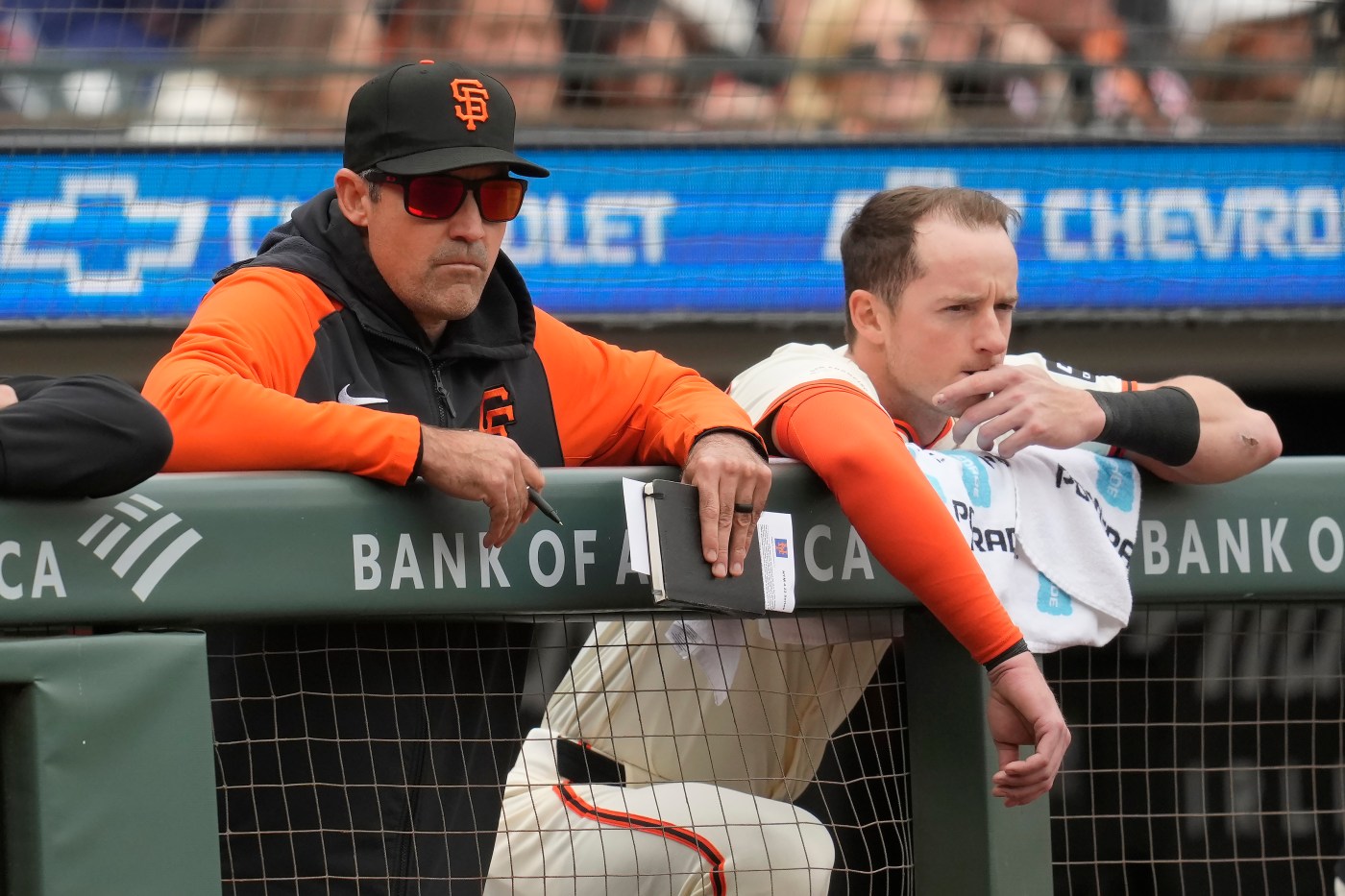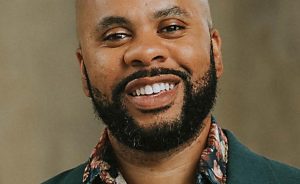PHILADELPHIA — What doesn’t show up on the back of Pat Burrell’s baseball card are the stretches, sometimes lasting a month or more, where he didn’t look like the slugger with four seasons of 30 or more home runs, two 100-RBI campaigns or who twice received MVP votes.
Burrell slumped, too.
That has been the message the now-47-year-old hitting coach has tried to use to reassure the group of Giants batters he is now in charge of, who have been stuck in a season-long rut and scored more than three runs Sunday for the first time in 10 games — with four.
Since April 23, the last time they had eclipsed three runs, the Giants have scored the second-fewest runs in the majors, averaging only 2.6 per game.
“As a staff, we’re just trying to keep everybody relaxed, keep working hard and things will happen,” Burrell said from the visitors’ clubhouse of Citizens Bank Park, new territory for the man drafted first overall by the Phillies and spent the first nine years of his career in Philadelphia.
All of Burrell’s aforementioned accolades came here, before matriculating to Tampa Bay and eventually to San Francisco, where the veteran presence he brought at the trade deadline in 2010 helped the Giants to their first of three World Series titles.
Shown on the big screen during Friday’s game, Burrell received a rousing ovation but didn’t offer any acknowledgement back. The camera captured him spitting a mouthful of seeds, then turning away. Back to work.
“Do I wish we were hitting better as a group? Of course I do,” Burrell said. “But I know how hard this is, too. I don’t have a ton of answers for you. The only thing we can do is to keep working.”
In his first year as the Giants’ hitting coach, Burrell is as frustrated as anyone, except perhaps the hitters of whom he is charge.
“A lot of guys just struggling to find the grass,” outfielder Michael Conforto said. “Everyone gets frustrated when they’re not doing what they’re capable of. I’ve been frustrated. … (Burrell) has been in our shoes. He’s had seasons where he’s started hot and he’s had seasons where he hasn’t started so hot. He’s able to put some things in perspective from a guy who’s been through it, understanding of how long the season is.”
Up and down the lineup, Giants hitters are hitting the ball hard when they make contact. They aren’t striking out at an obscene rate. Based on the quality of their contact, the Giants should be batting .246 as a team with a .399 slugging percentage, according to Statcast, but they are batting only .238 and slugging .371.
It just hasn’t led to results.
“I think guys are swinging at pitches we’re supposed to be swinging at; we’re putting balls in play,” first baseman LaMonte Wade Jr. said. “Sometimes it’s just right at people. That’s the game.”
In his first at-bat Saturday night, Wade swung at the first pitch and lined a single into right field. It was a departure from the typical approach of a hitter who saw among the most pitches per plate appearances in the majors last season and something the Giants hope to see more of from all their hitters.
“We’re far enough into the season that we can talk to some of our guys about adjustments that make sense,” president of baseball operations Farhan Zaidi said during his most recent appearance on KNBR. “One of the things that’s … a conversation we’re having is our hitters just being more aggressive when we get pitches to hit.
“We’ve got a few guys that like to take a pitch early in the count, and when the book gets out on you, you’re going to get fastballs down the middle. That’s probably going to the best pitch you get to hit in the entire at-bat.”
The Giants have stepped to the plate 1,280 times this season, and in 458 of those plate appearances, they have fallen behind 0-1 because they watched strike one. Right off the bat, they are putting themselves in a hole more often than the rest of the league — 9.2% of the time, compared to an MLB average 7.9%.
Leaguewide, hitters have a .584 OPS after falling behind 0-1 compared to a .785 OPS when taking ball one.
“For me, when I swing early in the count, I’m not as good,” Wilmer Flores said. “At least I feel that, I don’t know if it’s true or not.”
Flores watched strike three twice in Sunday night’s loss. Both pitches were fastballs and well within the strike zone, representing another teamwide issue.
The Giants have been rung up on fastballs 53 times, the eighth-most in the majors, and are watching even more go by early in their at-bats. More than 12% of the pitches they have seen — 615 total — have been fastballs called for strikes, the highest rate in the majors.
“When I played, we had one hitting coach. Maybe. Now there’s three guys,” Burrell said. “The information is there. How to interpret it so that it gets to each guy in a proper manner, that’s what I’m in the process of learning.”
Opposing pitchers have learned they can attack Giants in the strike zone to get ahead and coax them to chase outside the zone once in count leverage. They have seen more pitches in the strike zone than any other team but have offered at only 65% of them, the third-lowest swing rate in the league.
Conversely, the Giants are chasing 30.2% of the time they get pitched outside the strike zone, smack dab in the middle of the league.
That all adds up to a 8.2% walk rate, 22nd in the majors, turning a typical area of strength in Zaidi-built clubs into a weakness.
“I wasn’t a huge first-pitch person. I didn’t feel comfortable a lot of the time,” Burrell said. “My insecurities about how I hit and the pitches I had trouble with got in the way, so I wanted to see one first knowing I was going to get myself in a little bit of a hole. But I had to be selective at that point, and then I had to be willing to take a walk.
“If we have a more passive approach as a group, then we’re kind of fighting uphill the whole way through the at-bat. That’s fine, if you’re able to be selective and walk.”
Even if they were drawing more walks, though, the Giants have had a hard time driving in the runners who are already reaching base.
Related Articles
SF Giants take sigh of relief as Tom Murphy avoids surgery
SF Giants finally crack 4 runs, lose anyway as Logan Webb is roughed up by Phillies
Scranton’s Mason Black set to make ‘storybook’ MLB debut at Citizens Bank Park
Routed in rainy Philadelphia, SF Giants lose more than just a game
Tom Murphy leaves injured, throwing SF Giants catching situation into chaos
Jorge Soler, who was signed to be a middle-of-the-order run producer, has had no shortage of opportunities. He has taken 26 at-bats with runners in scoring position and has only three hits, a .115 average. He has driven in only three runs besides himself on his five homers.
As a team, the Giants are batting .233 with runners in scoring position, 23rd in the majors, between the Rockies and Angels.
Simply put, the Giants aren’t getting $209 million worth of production from the three biggest free agents they added to their lineup this winter. Of their offseason acquisitions, Soler leads the group with a meager .655 OPS; Matt Chapman’s is .620, and Jung Hoo Lee’s is eight points lower, at .612.
“To be honest, with Chappy and Soler and Jung Hoo, we have some new guys, there’s still a lot of coming together as a group that needs to happen,” Burrell said. “We’re getting there. Are we playing great? No. Do I think it’s gonna get a ton better? Yeah. Look, the guys are working their asses off. They’re committed; they give a (crap); they want to win. You’re probably seeing some guys pressing a little bit, trying to do too much.”












